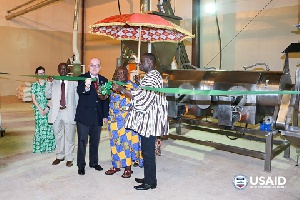A groundnut processing facility, which is aimed at boosting the country’s groundnut production chain, has been launched in Kumasi by Project Peanut Butter, a Non-Governmental Organisation (NGO).
The facility, which would increase demand for locally grown aflatoxin-free groundnuts, was provided by the United States Agency for International Development (USAID), in partnership with The Hershey Company and Rotary International.
Aflatoxin is a toxic carcinogen that sometimes strikes when agronomic conditions are not ideal, and this is disadvantageous to dealers in the groundnut business.
Project Peanut Butter aims at combating under-nutrition by producing effective ready-to-use therapeutic foods, and would use the facility to roast local groundnuts for “Vivi,” a groundnut-based nutritional supplement.
This was in a statement issued by the USAID and copied to the Ghana News Agency in Accra on Wednesday.
The “Vivi,” is a product of The Hershey Company, which is a key part of Government’s School Feeding Program, the statement noted, adding: “The Hershey Company is currently providing 52,000 students with "Vivi" per day.”
Mr Robert P. Jackson, the U.S Ambassador to Ghana, joined Mr Ibrahim Awal Mohammed, the Minister of Business Development, and Mr Simon Osei-Mensah, the Ashanti Regional Minister, among other personalities, to launch the facility, which would create more income for groundnut farmers.
“Today’s launch is about the power of partnerships, and the facility will enhance the efforts of the partners to improve food security, incomes, and nutrition in collaboration with the Ghanaian Government, private sector, and communities,” Mr Jackson was quoted as saying.
The statement said the facility was part of the USAID’s project dubbed: Strengthening Partnerships, Results, and Innovations in Nutrition Globally (SPRING), which was part of the Feed the Future Initiative, that sought to combat malnutrition among children.
“In Ghana, USAID works through Feed the Future to boost the incomes of smallholder farmers, improve agricultural productivity, link farmers to markets, and improve nutrition,” it added.
Business News of Thursday, 24 August 2017
Source: ghananewsagency.org

















